On the Road is a weekday feature spotlighting reader photo submissions.
From the exotic to the familiar, whether you’re traveling or in your own backyard, we would love to see the world through your eyes.
Kabecoo
This is the third and final post about the Skyline Trail in Olympic National Park.
After a few days of increasing concerns about water, I could not help but drop off the trail to camp at an entirely reliable source: the cleverly named Lake Beauty.
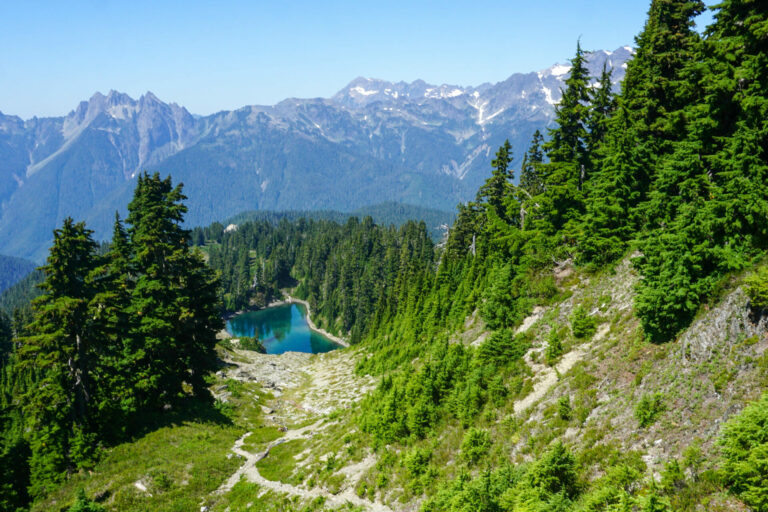
Lake Beauty sits a few hundred feet below the path. No fish there but lots of mountain newts. It was serving as a local watering hole for more than just a few hikers: surrounding meadows crossed by animal trails, lots of purple scat from the berry-eaters, and a variety of footprints from boots, hooves, and paws.
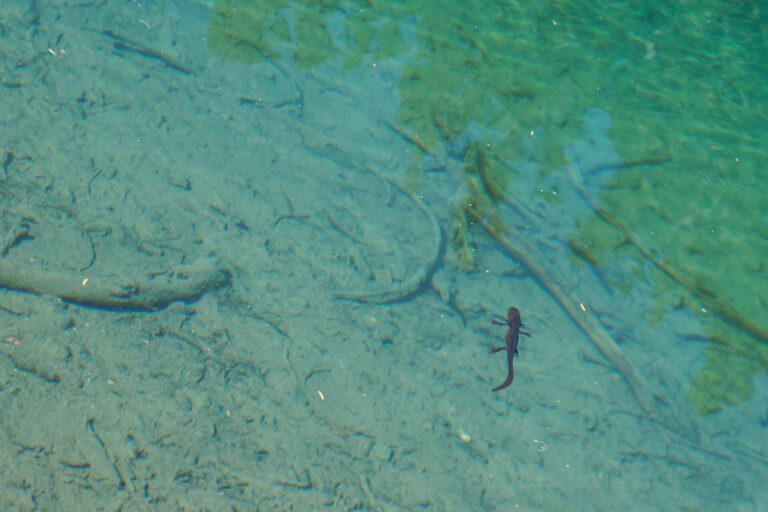
Did I mention there were newts? They float there, so yummy looking, I don’t know how they survive.
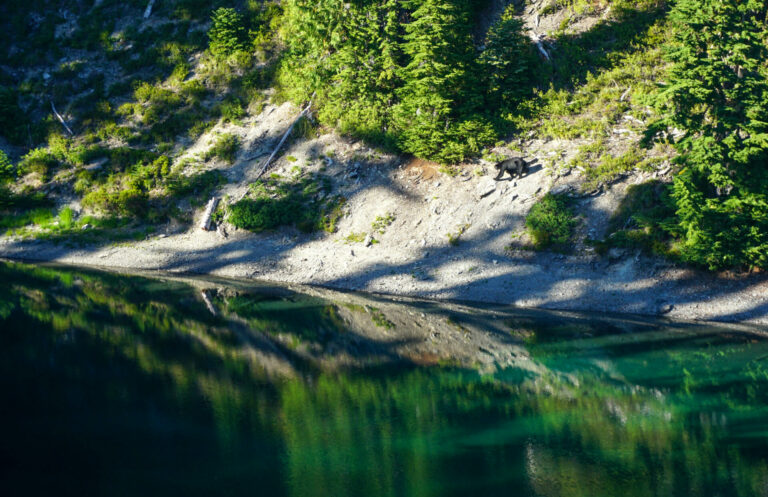
The campsite at Lake Beauty sits behind some low brushes, making it easy to watch a local bear (middle right of photo, clothed in black) descend to the lake and go for a quick dip. Couldn’t blame him; I had done the same thing an hour before.
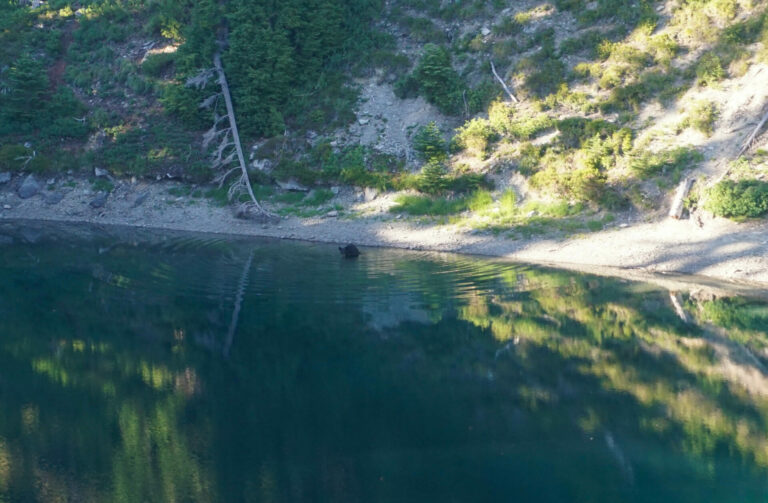
I had seen bears swim several times before; the first time, many years ago, I was already in the water when one decided to join me. This one was simply cooling off a bit and climbed out after sitting there a minute or two, returning to finish off a few huckleberry bushes.
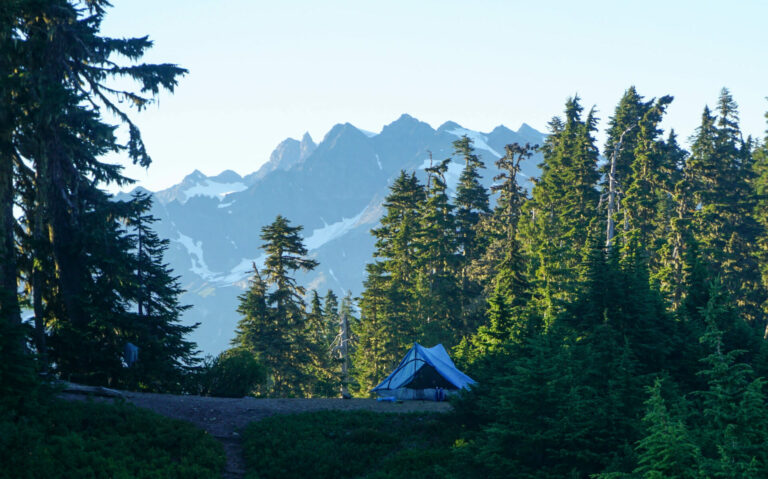
My tent with Mt. Olympus in the distance. I tend to avoid more popular campsites but I had the basin all to myself, except for the bear and some morning elk. I appreciated having a flat place for the tent with a wind break all around provided by the trees and shrubs. I had spent the last two nights on rocky uneven ground and this was heavenly.

The final leg of the Skyline Trail goes from Lake Beauty to Low Divide, the pass at the headwaters of the north fork Quinault River. The trail winds around the southern and eastern sides of Mt. Seattle, named by the Press Expedition in 1890 after a local community, looming over the west end of the pass.
From Lake Beauty the trail drops to a broad drainage, where Seattle Creek must be crossed. This year there was little water in it, but in many years it remains covered by snow well into September. In 2012 I encountered challenges crossing the creek’s snow bridge but in 2023 a single step reached the other side.
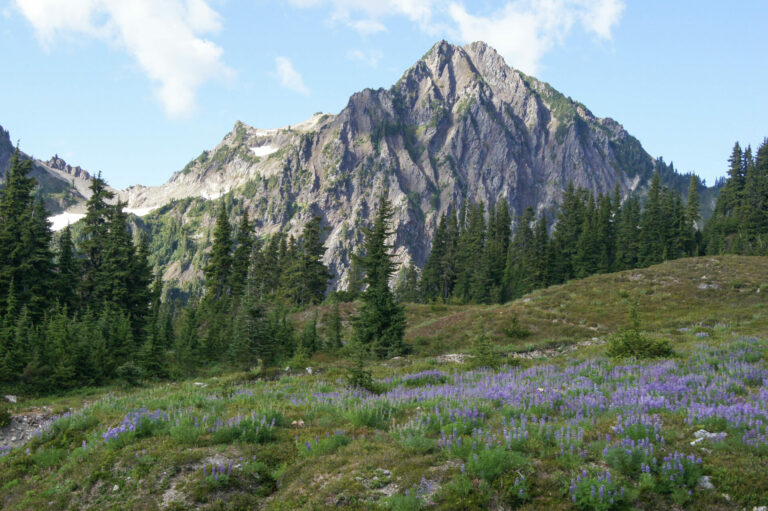
The trail climbs to classic mountain meadows over the next mile. In most years there are small tarns throughout the meadows as well as multiple small streams from snowfields above. A flattish area about half a mile from the trail is a popular off trail destination for those who come to climb the nearby peaks.
That’s Mt. Noyes across the drainage, named for the publisher of the Washington Evening Star in 1889.
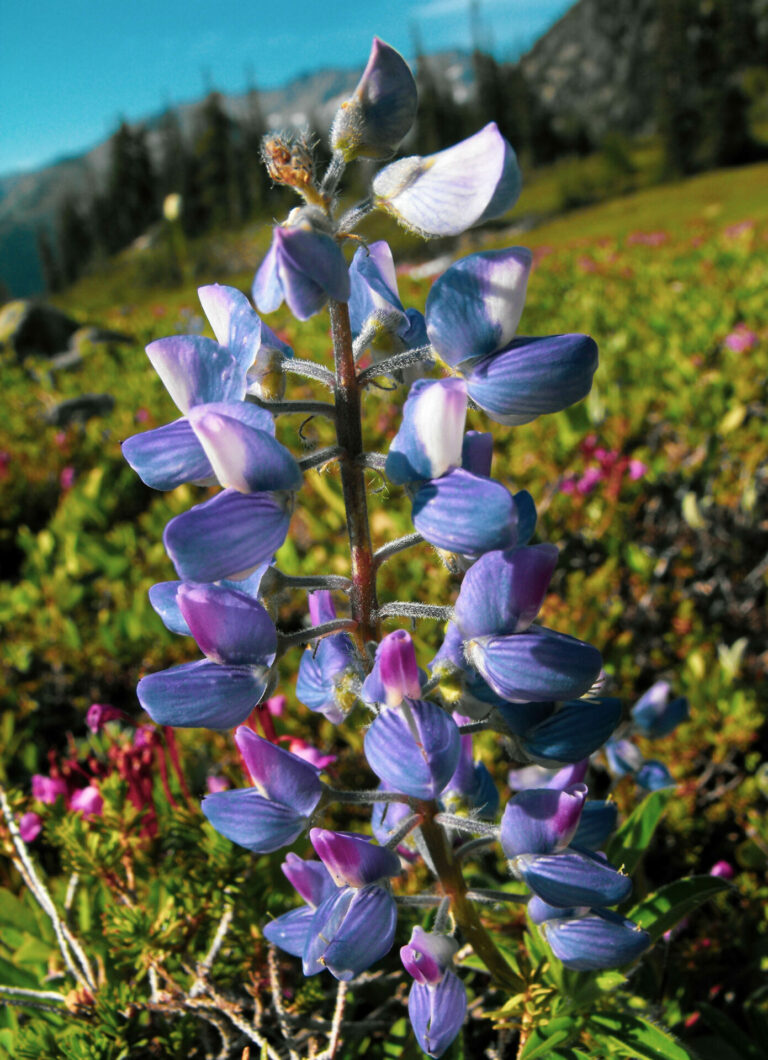
What would the meadows be without lupine?
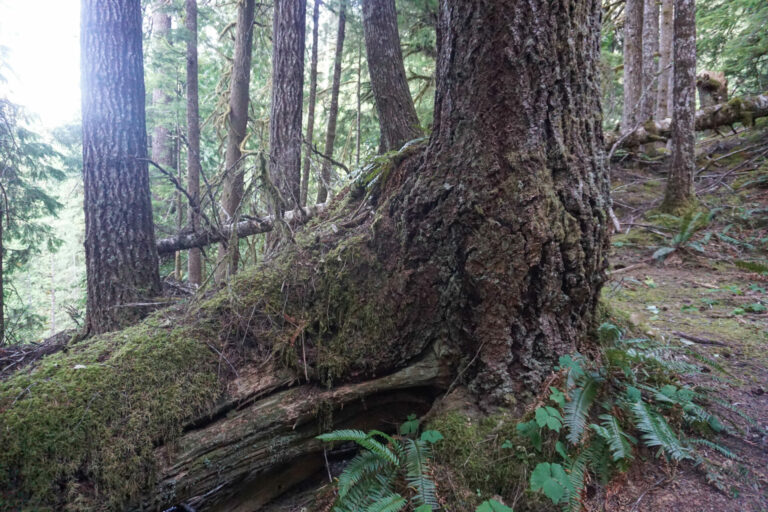
After the meadows the trail descends to its terminus at Low Divide. The Skyline ends at this point though the trailhead (and car!) is still over 16 miles away. An easy trail connects the trailhead and Low Divide. The footing improves, the trail widens, the river stays near.
I camped about halfway down, finding a soft spot below a huge cedar that fell decades ago. The cedar was serving as a mother log to an enormous Douglas fir that grew out of and partially covered the cedar’s root ball. In another few hundred years the Douglas fir may serve as another mother log!
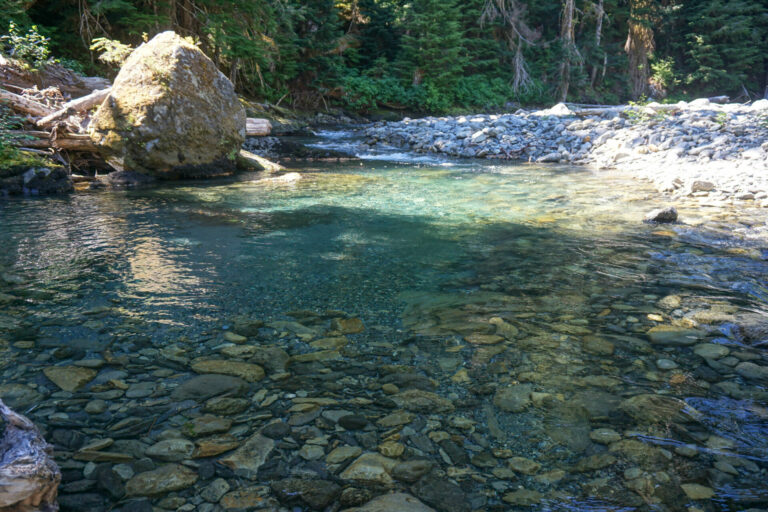
After a few miles, one final obstacle remained: crossing the Quinault river. In the spring, or in years of high water, the crossing can be dangerous. The water is fast and cold. If it’s too deep or dangerous, the sad hiker must return along the Skyline route or walk out the north side of the park. Neither is a good option.
At last I had a chance to appreciate the lack of water in the high basins. The crossing was simple as the water got knee-high but no more.
This pic was taken just above the crossing and the water in the pic is deeper than it was at the ford.
After crossing it was an easy matter of walking mostly downhill. Ending the route with a gentle descent to a popular trailhead allowed me the opportunity to get used to seeing people and having to talk.
Thank you for taking this trip with me….

JPL
Thank you for sharing your adventures with us. What an experience.
Wag
Love the lupine shot!
Dagaetch
So pretty. I’m not much of one for camping, but your pictures are making me think it might be worth it!
Nelle
Thank you. Helps me remember old hikes from long ago.
OzarkHillbilly
Must be a lack of raccoons. Great pics Kabecoo, thanx much.
Another Scott
Thanks very much for the pictures and narration. Very evocative. A great way to start the day.
Cheers,
Scott.
Mike S. (Now with a Democratic Congressperson!)
In general newts are very toxic. and those in the Pacific NW are reported to be the most toxic species (except for the ‘Gingrich’ variety!).
Iit is tetrodotoxin in their skin. The same chmical as in Fugu.
Mike in Oly
The newts are safe because they are toxic to most predators. Altho I have seen great blue herons eat them. Wonderful series. Thanks for taking us along on the hike.
Anyway
@Dagaetch:
Yep, same here. Love hiking but wary of camping but this made me wish I could do it. Great series – both pics and stories. Loved the interweaving of pics from earlier trips. So glad you did it and thanks for sharing, Kabecoo
twbrandt
Great pictures and stories! Thanks for sharing. The PNW is definitely on my list.
Kabecoo
@Mike S. (Now with a Democratic Congressperson!): quite glad I wasn’t hungry.
thank you all for the kind comments!
SkyBluePink
Your pictures have captured the majesty of nature!
mvr
Lovely photos! Thanks for the whole series.
cope
Wonderful pictures and great narration, thank you. You are so lucky to have these memories and photos to nurture you. And to have taken this particular journey more than once must have been a real treat. Not that I could physically do them again but my epic hikes, mostly in 1970’s Colorado, would probably bring me to tears given how crowded and over-used wilderness in some places around here have become.
Thanks again.
Madeleine
Thanks for the pictures and hiking stories these last three days. Beautiful and interesting.
BigJimSlade
Yummy newts? Maybe if they were gummy newts!
BigJimSlade
I really like all the craggy shapes in Mt. Noyes :-)
I assume you had to use bear cannisters to store your food, right? Was there much to worry about from the local wildlife? Obviously, you’re not walking up to bears and asking them for selfies, but did you have to do much else besides keep a safe distance?
KSinMA
What a great journey. Thanks for sharing, Kabecoo!
pieceofpeace
These are amazing shots – love the pointy, craggy Mt. Noyes, which manages to look majestic in your picture. I’d give hiking and camping here a shot for the beauty you convey through photography, all waiting to be awesome and soaked up, even the bear.
You captured the essence of nature, imperfect that leaves one with lasting impressions within. For now, the pictures will have to do, and they do very well. Thank you.
Kabecoo
@BigJimSlade: I carry a lightweight (sort of) bear canister and an ursack, a bear resistant sack. I can fit almost a week of food in the canister, so I eat the ursack food first, figuring that if something gets into the food I’ll always have a week of food left. On this trip I brought nine days of food.
I don’t do much of anything to avoid bears (mothers/cubs are the exception), but rarely have I followed one around. Black bears have excellent hearing and smell, so usually they are watching me long before I see them. I have never felt like a target, and the few times I’ve been within a few feet of a bear, we have both been startled and the bears have run away faster than I ever could.
I avoid being close to elk. Most of my long hikes are in August and September when they are bugling, rutting, fighting, and they are enormous. The large males also defend the herd with hooves and antlers. They are also beautiful….so I’m torn between getting a better photo and saving my skin. But one of my consistent promises to my spouse is “I won’t do anything stupid” so I don’t ever try to sneak closer to elk (even though I do that with bears!)….
Mountain goats are not much of a threat in the Olympics any longer.
I also would again thank everyone for reading along and commenting. I love being out in the woods and mountains and bringing some of that to you.
Dan B
I’ve done most of my hiking in the Cascades: Alpine Lakes, Glacier Peak, Mt. Baker / Northern Cascades which are higher elevation than the Olympics but this trail seems just as rocky and rugged. The first time you hiked it with just cairns it must have been nerve wracking.
Dan B
The biggest dangers I had hiking were the Chelan Lakeshore trail in mid May. Rattlesnakes had emerged from their burrows and lined the trail. The other time was when I ran out of daylight and camped 20 miles from the nearest road on the trail. A Buck was startled by me and started jumping around. I thought I’d be skewered by his hooves.
tybee
Thanks for the journey. beautiful pics.